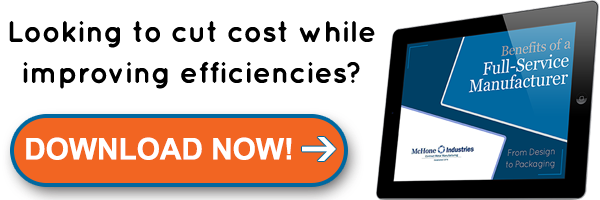 Cutting, bending, joining: There are many ways to produce your metal project. Design for manufacturability (DFM) techniques help optimize the design, but only if used with a manufacturing cost model.
Cutting, bending, joining: There are many ways to produce your metal project. Design for manufacturability (DFM) techniques help optimize the design, but only if used with a manufacturing cost model.
Here we'll explain what a cost model is, and how it can help simplify your production process.
Manufacturing Cost Model Basics
Every manufacturing process has a set of variables that drive the cost of production. The most obvious are:
- Volume
- Cycle time or part rate
- Setup time
- Tooling costs
- Energy consumption
- Floor space maintenance costs
Volume’s a big one. You'll use different processes and equipment to produce one part or a few prototypes versus making hundreds or thousands of pieces.
A manufacturing cost model lets you juggle these factors to arrive at a cost per piece. Will laser cutting be cheaper than turret punching? The cost model reveals that, plus much more.
Cost Model Creation & Maintenance
Experienced engineers have a cost model in their head. They know the laser is better than the turret punch for certain jobs and quantities. It's not a very scientific approach though, and it's easy to overlook alternatives and design peculiarities. As industry magazine The Fabricator asked several years ago, “... is that the preferred mode of operation for a shop that may have the narrowest of margins?”
Business that do a lot of quoting often keep a cost model in spreadsheet form. Factors like setup time and operation speed are programmed in, and the spreadsheet produces a unit cost for each operation.
Without good discipline, the data in these spreadsheets gets out of date. The spreadsheets themselves can grow unwieldy, and to save time engineers make their own copies. Updating these uncontrolled versions becomes impossible, and there's always the risk of confidential information reaching competitors. The answer is to move to manufacturing cost model software.
There are several online cost estimation tools that work well. These do a better job of maintaining process data than is possible with a spreadsheet. They employ more advanced algorithms, produce more precise results, and keep data secure. And they improve consistency between estimators.
Here are a few example tools:
An alternative approach for a designer or buyer needing good estimates is to involve a one-stop shop early in the design process. A fabricator with a range of equipment under one roof will likely be able to suggest design changes to lower manufacturing costs.
Linking to Design & Process Selection
The concept of design for manufacturability is a tool for tweaking part or product design to make it easier to produce a successful product. That has to be done with knowledge of how those changes impact product cost. For example, DFM pushes you to reduce piece count in an assembly. That reduces the welding needed but complicates blanking and forming. Your cost model helps you determine the optimum number of components.
The cost model also enables better manufacturing process selection. To give a simple example, you could shear blanks from sheet, then move them over to a notcher and a punch press. Alternatively, the turret punch could produce all the holes. It's a more expensive machine to run, but the part comes out ready for forming. The cost model helps guide your decision making.
Now consider a different scenario. Designs want to tighten up some tolerances. (Perhaps someone thinks the product will perform better.) A good model lets you explain how that changes the processes needed and the impact on product cost. Rather than arguing from opinion and past experience, you now have data from a computer program to sway management's opinion.
One-Stop Shop Benefits
The ability to optimize processes and lower costs is limited to the tools and equipment available. A shop that performs a limited range of operations – blanking and folding for example – can't optimize over the whole manufacturing process. Conversely, a one-stop fabricator with a wide range of processes under one roof has a much greater ability to drive down cost.
Driving Down the Cost of Manufacturing
Fabrication is a complicated business. Whether cutting, folding and welding sheets, or forming and bending bars and tubing, there are a host of processes you can use. Design plays a part in process selection, and so does cost.
A good manufacturing cost model helps drive design iterations that lower costs and support business growth. And the more processes addressed by that model, the greater the cost reduction potential.


